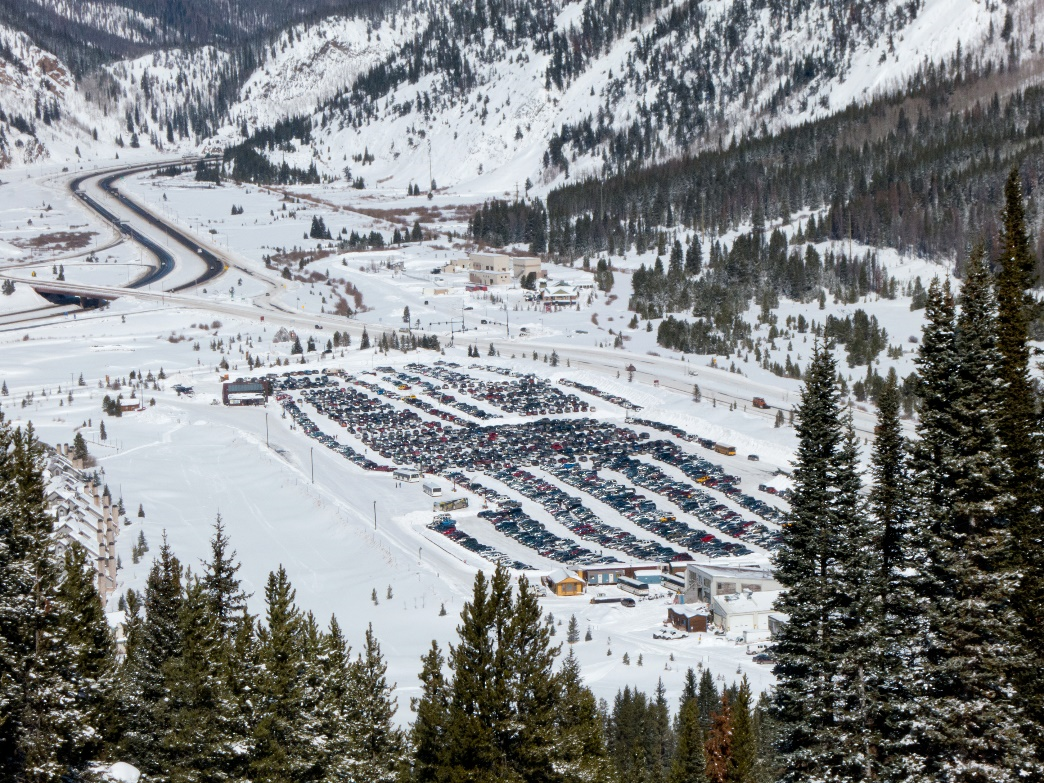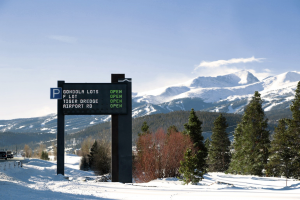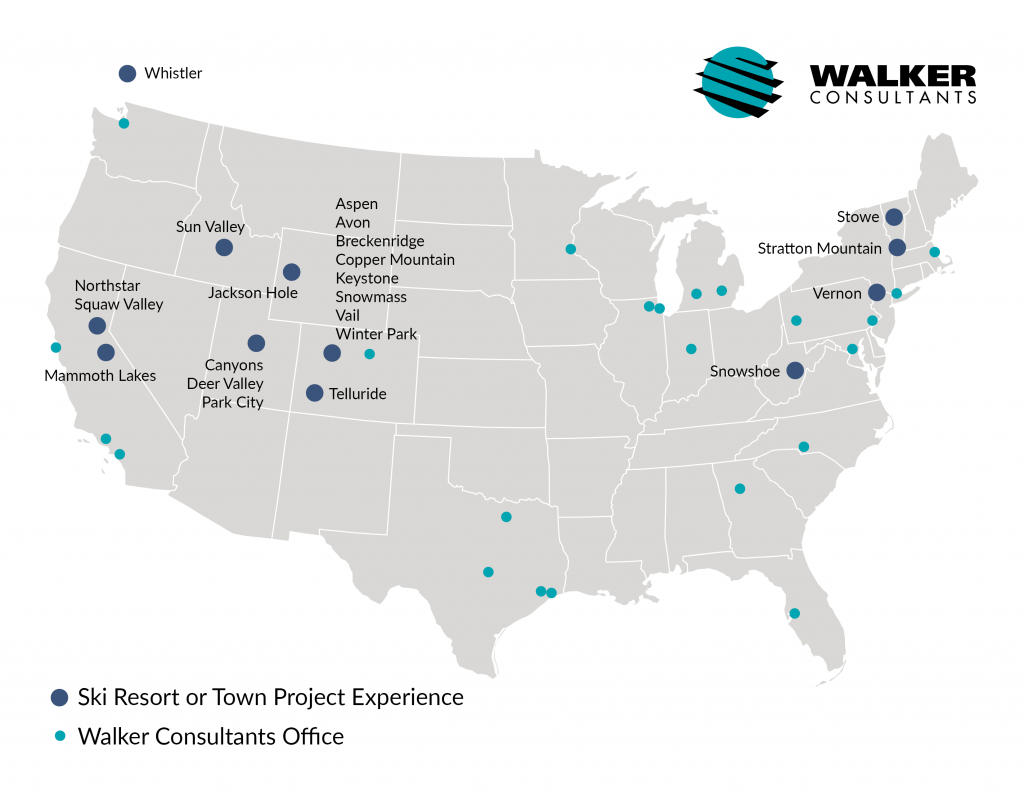By Andrew Vidor, Director of Planning, Operations, and Technology, Denver
Parking Management and Operational Strategies
Parking at ski resorts has long been an important operational consideration. No matter how many epic powder runs, how good the dining experience, or the many lasting memories made on the mountain, parking is the first and last experience your customers have at the resort. Having an excellent parking experience allows your customers to relish in the memories created while at your resort. Thus, it’s our goal at Walker Consultants to help facilitate that experience and get visitors (and employees) where they want to get: to the powder.
Given the pandemic, many travelers are opting to drive to destinations with a few hours of their home. Parking will look different this ski season, and the impacts will vary by region of the country and from resort to resort. Each resort will need to consider its unique operating circumstances to understand the impact on its parking situation this winter.
We predict changes to the transportation system serving your resort (both resort-operated transportation systems and those operated by other transit agencies). Expect:
- Reduced capacity and/or frequency of service required by state and local jurisdictions.
- Increased wait time for transit users at remote, off-site parking, and intercept areas.
- Increase in customers driving to resort’s onsite parking facilities more frequently, increasing the already high demand for parking, out of necessity or preference.
- Decrease in carpooling, especially from those with health concerns
- Increase in patrons driving to resorts from out of state rather than flying and taking other transportation options such as shared-ride vans, public transit, or Uber Ski/Lyft Ski Rack.
One way to ease uncertainty? Technology’s ability to assist in planning, operations, and customers having access to that critical information ahead of time. While most parking lots will fill as they usually do, having the ability to manage the system more efficiently will be an important consideration for winter operations. Efficient management of the system will position you to effectively plan for the allocation of staffing resources, their location, and the information they have available to communicate to your customers. Customers could also make more informed and personalized choices, ultimately resulting in a better experience. This article focuses on parking management strategies to consider implementing with your modified resort operations this winter.
Contactless Strategies to Pay for and access Parking
While contactless payment strategies are nothing new, leveraging their features has never been more important, for your staff’s safety and your customers’ preferences. Mobile phone applications are a great way to process these contactless parking payments in your facilities where you charge for parking. There are a variety of mobile payment vendors on the market and the selection of one vs. another needs to be considered as part of your overall parking operations and technology strategy. Regardless of the vendor, these apps allow the driver to process their payment without having to interact with staff or automated payment stations, while sitting in the warmth of their car before booting up, or riding the cabriolet on the way to the base of the village. Better yet, if you offer hourly parking options, parking fees can be paid for and extended into après ski without having to return to a payment machine.
Enforcement can be handled in several ways: LPR (License plate recognition) and staff with mobile handheld devices
- Enforcement vehicle mounted LPR cameras record license plates while driving through the parking facilities. Because the payments are associated with a vehicle’s license plate number, these systems efficiently reconcile the paid vehicles with those that are unpaid.
- Another option is the use of staff equipped with mobile handheld devices to reconcile the paid vehicles with those that are not. Keep in mind, this option is less capital-intensive, however, staffing heavy.
In both cases, these systems are connected to the mobile payment platforms as well as payment machines and will alert the enforcement officer if a vehicle has not paid. A citation can then be issued to that vehicle, along with information about parking regulations and ways to pay for the guest’s future visits. From an operational perspective, contactless payment offers a safer transaction for the customer and staff: less cash handling, less close contact with the customer, better auditing control, and a reduced number of staff to manage the payment process.
Reservations

Whether your resort is requiring or not, parking reservations are another amenity to enhance the customer experience. Given that many consumers intend and/or be required to plan their trip in advance, access to pre-paid parking is another way to enhance their overall experience.
- Pre-paid reservations can easily be managed at gated parking areas by issuing a unique customer QR/bar code at the time of booking. Upon arrival, the customer presents the authorized credential for access, the gates automatically raise, and the parker enters the facility.
- For non-gated parking areas, the QR/bar code is presented to the parking lot attendant upon arrival at the resort. For non-attended lots, the vehicle’s license plate can also be used as the “paid credential”, if a license plate recognition system is employed for enforcement (like the pay by phone option described above).
Parking reservations from an operational perspective allow you to proactively manage your system, pre-guest arrival. Further, reservations generate pre-arrival revenue and increase revenues for premium parking. Another option is converting some general on-site parking spaces to premium parking to generate upside revenue.
Parking reservation systems can be stand-alone platforms, integrated with your existing parking access and revenue control equipment, or part of your existing resort reservations systems. The particulars of how it integrates with your back-end management system will largely depend on the you choose. In some cases, pre-paid and reserved parking access can be integrated with season ski passes as an added convenience. From the customer perspective, the process is relatively simple and adds another amenity for those who desire this convenience.
Communication, Communication, Communication
As you continue to communicate your operational plans and procedures for the season, information about your plans related to parking should also be considered, especially if they include enhancements or changes to the customer experience.
Ongoing communication during the season can also help your guests plan for and react in real-time to parking, especially when in route.
- Social Media: Communicate information about the status of key parking areas via your social media accounts during busy mornings (EG: Parking Lot X is full, please use Lots Y and Z).
- Digital Message Boards: Deploy digital message boards to indicate the status of parking availability. Providing this information in real-time and before arrival at the resort will help reduce traffic congestion and make the experience more seamless. There’s nothing more frustrating than arriving at the parking lot to find out it’s full after passing multiple empty lots along the way. If it’s too late this season to deploy permanent infrastructure changes, trailer-mounted digital boards and the trusty “sandwich board” will still work.
Regardless of the technology, the important thing is to communicate the parking alternatives when one option is full.
Ready to learn more?
Like the ideas you read about? Need some additional information? Not sure where to start?
Don’t hesitate to reach out to Andrew Vidor and “kick the tires” on these ideas or other parking questions. Andrew can be reached at avidor@walkerconsultants.com or via telephone, 810.265.2639.
About Walker Consultants
Walker Consultants is a national planning and engineering firm that specializes in solving parking-related challenges faced by our clients. Walker has worked with ski resorts and mountain communities across North America to solve a wide range of issues related to parking including operations, design, and technology implementation. Our experience with providing practical and implementable solutions allows your operation to achieve its potential and maximize the guest experience.
Walker’s Mountain Town Experience
About the Author
A lifelong skier and junkie for the outdoors, Andrew Vidor is the Director of Planning, Operations, and Technology in Walker Consultants Denver, Colorado office. His areas of expertise in the parking industry focus on consulting, planning, project management, technology, the basis of design, and identifying improvements for existing parking systems. Andrew has worked around the world with a vast array of client types. His subject matter knowledge in parking has been published in notable trade magazines and he has presented at industry conferences across North America. Andrew’s approach to projects is to provide practical, achievable, and implementable solutions to the array of challenges, problems, and opportunities for his clients.




